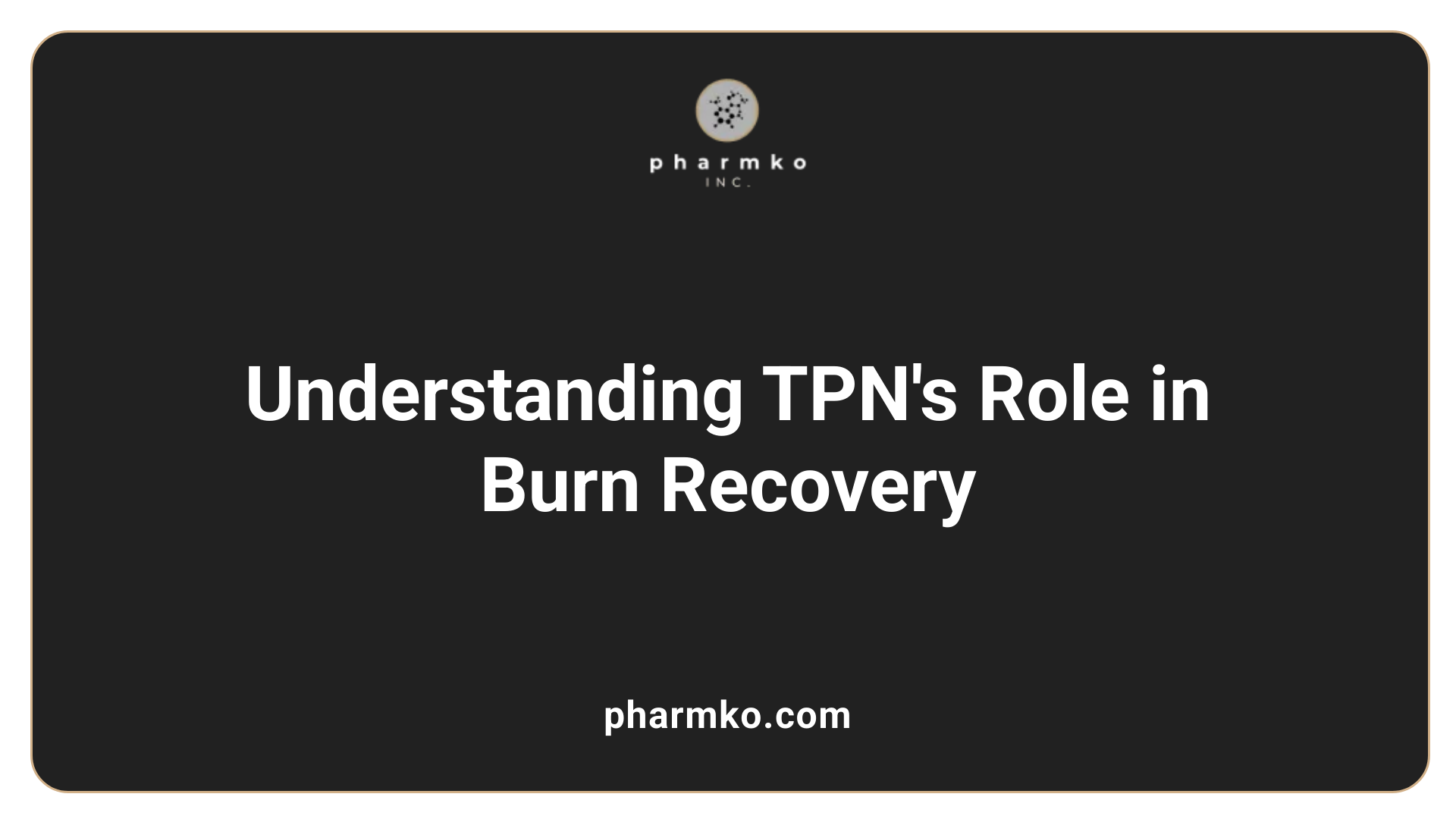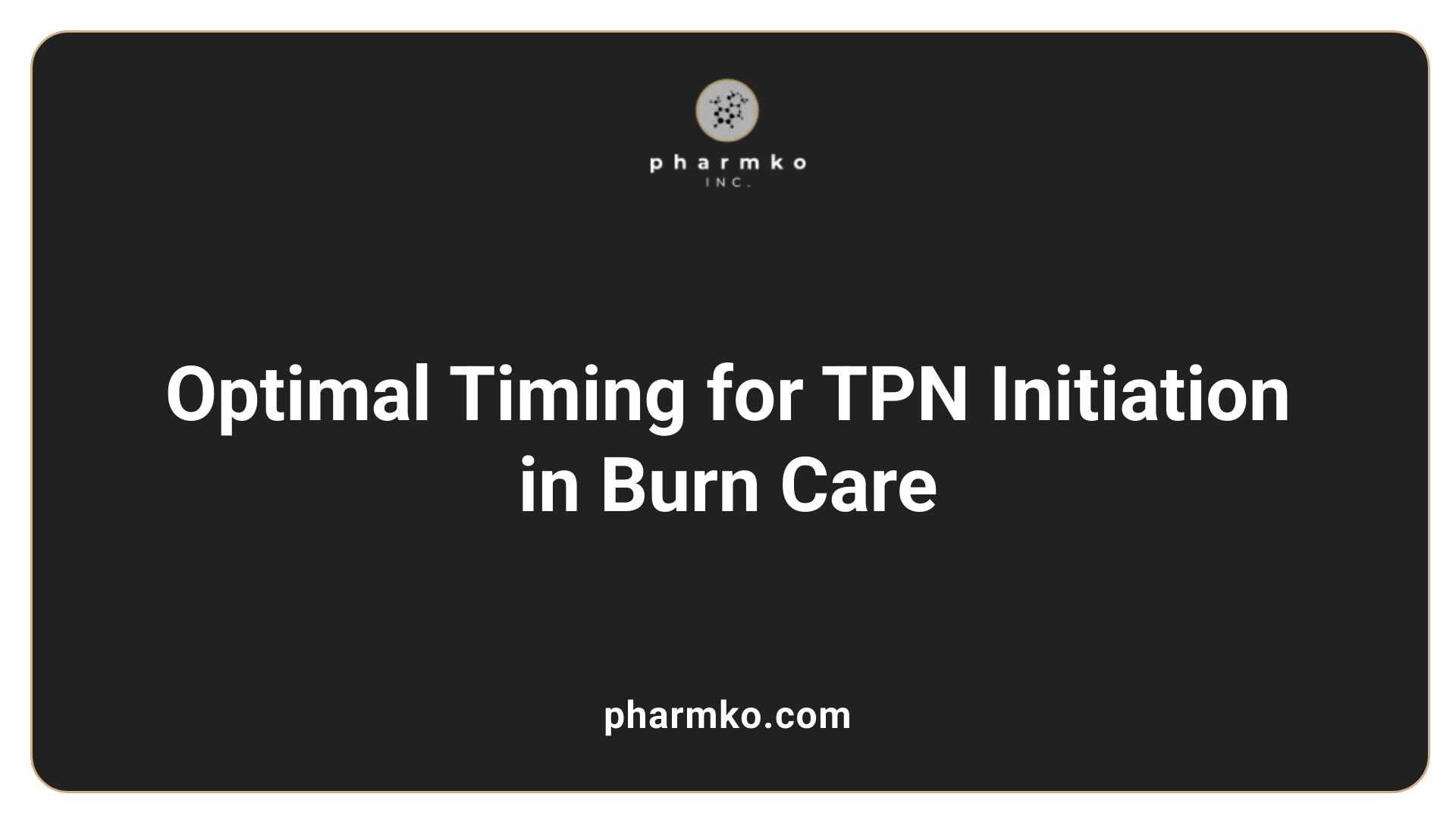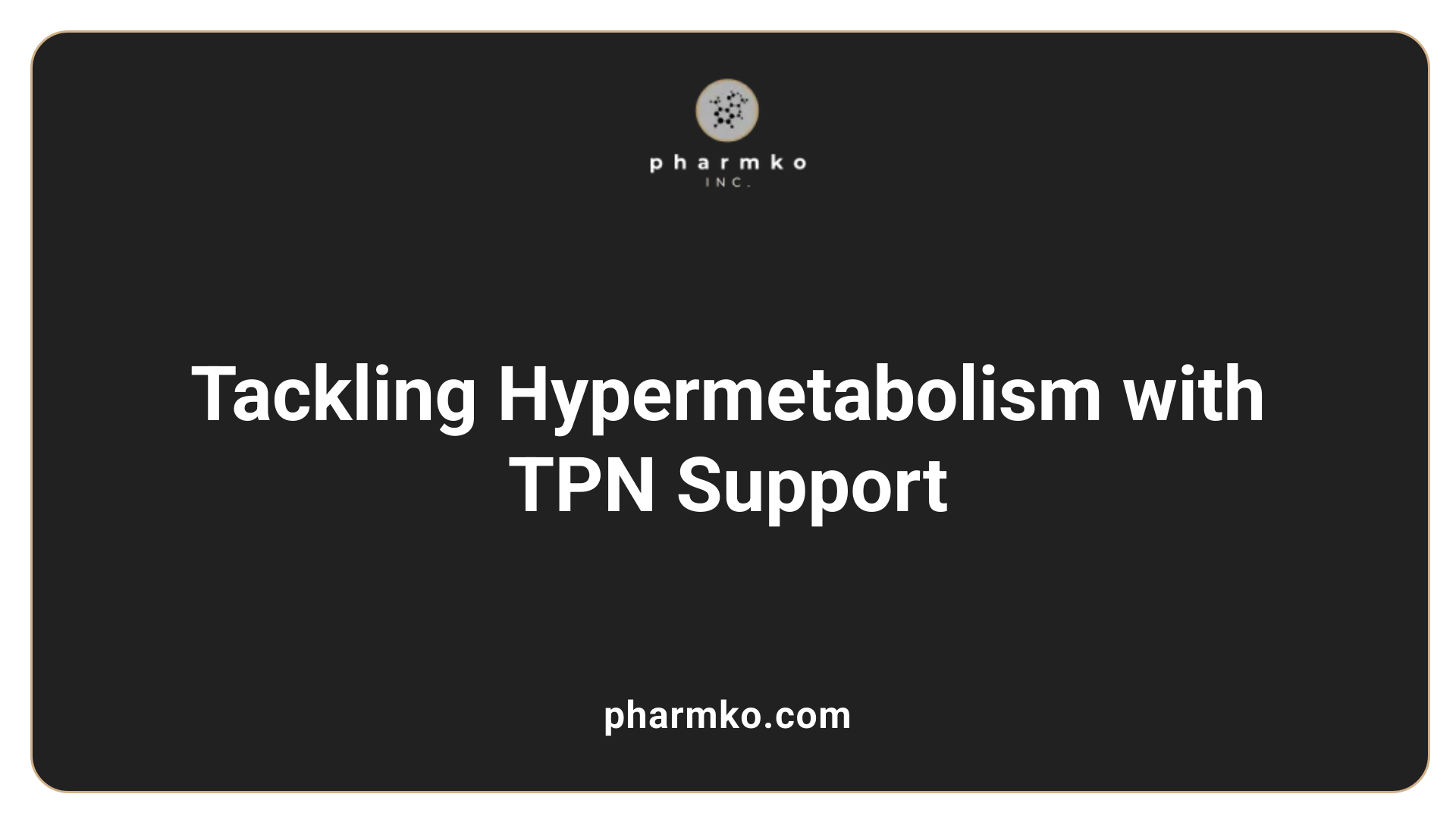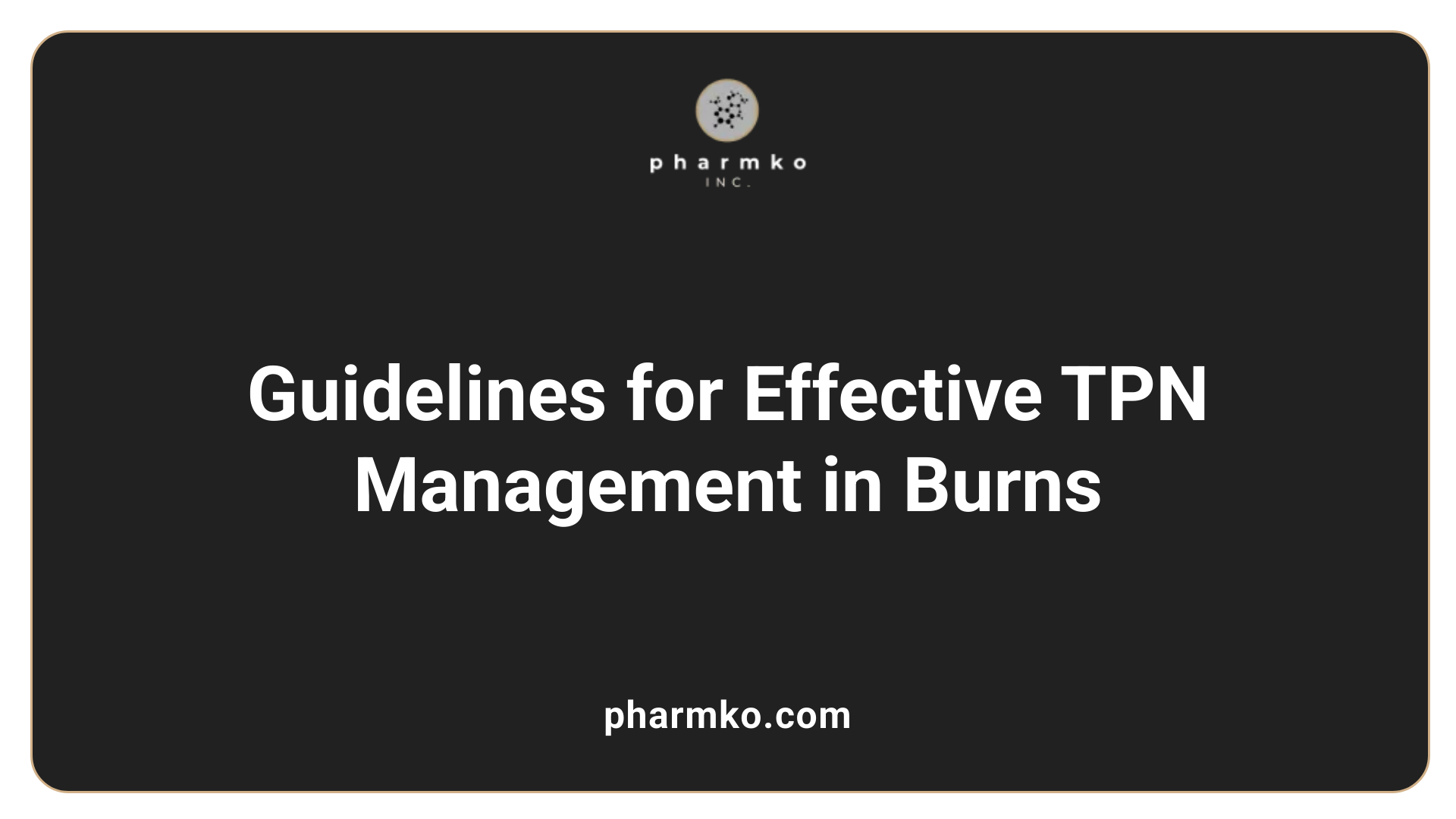The Role of TPN in Burn Victim Recovery and Nutrition Support
Understanding Nutritional Support in Burn Care
Effective nutritional management is fundamental to improving outcomes for burn victims. The hypermetabolic and catabolic states induced by severe burns necessitate tailored strategies to meet increased energy, protein, and micronutrient demands. Among these, Total Parenteral Nutrition (TPN) has played a historical and still relevant role, especially in cases where enteral feeding is contraindicated or inadequate. This article explores the multifaceted role of TPN in burn recovery, its integration with other nutritional interventions, and the latest advances guiding its optimal application.
The Initial Role of TPN in Burn Management

What is the role of Total Parenteral Nutrition (TPN) in the nutritional management of burn patients?
Total Parenteral Nutrition (TPN) has historically played a part in supporting severely burned patients, especially before the wider adoption of enteral feeding. Its primary function is to deliver essential nutrients directly into the bloodstream, bypassing the gastrointestinal tract. TPN provides elemental nutrients, including amino acids, glucose, lipids, vitamins, and minerals, which are dissolved in a sterile solution.
This method is particularly useful when patients cannot tolerate enteral feeding due to gastrointestinal dysfunction, such as decreased motility, bowel ischemia, or severe injury that makes gastric feeding risky. TPN helps to meet the increased nutritional demands—often doubling the basal metabolic rate—necessary for wound healing, immune function, and recovery.
However, despite its ability to provide complete nutrition intravenously, TPN has certain drawbacks. It may contribute to complications like bacterial translocation, fatty liver, increased infection risk, and gut mucosal atrophy, as it does not stimulate the gut's immune functions.
In recent years, the focus has shifted towards early and aggressive enteral nutrition because it better preserves gut integrity and modulates the hypermetabolic response more effectively. Thus, while TPN is valuable in specific cases where enteral feeding isn’t feasible, it is generally reserved as a secondary option.
How TPN delivers elemental nutrients without digestion
Unlike enteral nutrition, which relies on the digestive process, TPN supplies nutrients directly into the bloodstream, making it a form of parenteral (meaning 'beside the intestine') nutrition. The solution contains amino acids, dextrose, lipids, electrolytes, and micronutrients in a form that can be rapidly absorbed and utilized by the body.
This approach ensures immediate availability of calories and substrates needed for tissue repair, especially when gastrointestinal absorption is compromised. In burn patients, where high metabolic rates increase energy and protein needs, TPN can sustain vital organ functions during critical phases of inflammation and healing.
Transition to favoring enteral nutrition
Despite its benefits in specific circumstances, clinical practice has evolved to favor early enteral nutrition in burn care. Enteral feeding supports the preservation of gastrointestinal mucosal integrity, reduces bacterial translocation, and retains immune functions of the gut.
The consensus now encourages initiation of enteral nutrition as soon as the patient is hemodynamically stable, typically within 24 hours of admission, to capitalize on these advantages.
Parenteral nutrition like TPN is concentrated in cases where enteral routes are contraindicated or inadequate, such as intestinal paralysis, severe malabsorption, or required bowel rest. Overall, the trend is towards early, continuous enteral feeding, with TPN serving as a supportive measure when necessary.
Timing and Strategies for TPN Administration
 In the management of burn patients, total parenteral nutrition (TPN) is primarily reserved for cases where enteral feeding is contraindicated, not tolerated, or fails to meet the heightened nutritional requirements. The optimal timing for initiating TPN is closely tied to the overall strategy of early nutritional support. Current evidence underscores the importance of starting nutritional support promptly, ideally within the first 24 hours after admission, to counteract the profound hypermetabolic and catabolic responses that follow severe burns.
In the management of burn patients, total parenteral nutrition (TPN) is primarily reserved for cases where enteral feeding is contraindicated, not tolerated, or fails to meet the heightened nutritional requirements. The optimal timing for initiating TPN is closely tied to the overall strategy of early nutritional support. Current evidence underscores the importance of starting nutritional support promptly, ideally within the first 24 hours after admission, to counteract the profound hypermetabolic and catabolic responses that follow severe burns.
Early enteral nutrition (EN), ideally within 24 to 48 hours, is preferred because it helps preserve gut integrity, decreases bacterial translocation, and attenuates systemic inflammation. When EN cannot be established rapidly—due to factors like gastrointestinal motility issues or contraindications—TPN becomes necessary to prevent malnutrition and support wound healing.
Delaying nutritional support, including TPN, can lead to worsened outcomes such as increased infection risk, delayed wound healing, and greater lean muscle mass loss. Therefore, clinicians aim to initiate nutrition as early as possible. If enteral feeding is not feasible within this timeframe, TPN should be started to meet the patient’s caloric and protein needs.
In summary, TPN should be administered during burn recovery when enteral nutrition cannot be initiated or sustained effectively. The strategy involves starting nutrition early—preferably within 24 hours post-injury—to mitigate the hypermetabolic response, improve outcomes, and reduce complications associated with delayed nutritional therapy.
Nutritional Needs and Composition of TPN in Severe Burns
What are the key considerations for the administration of TPN in burn patients?
Total Parenteral Nutrition (TPN) becomes an essential tool when enteral feeding is not feasible or insufficient in burn victims. Proper TPN formulation requires careful assessment of the patient's unique needs, which are significantly elevated due to hypermetabolism—often increasing energy expenditure by up to 150%.
Early initiation is crucial, especially if the patient cannot tolerate enteral feeding within 48 hours. TPN formulations should be designed to provide high carbohydrate content, moderate protein levels ranging from 1.5 to 2 grams per kilogram of body weight daily, and limited fats to prevent complications such as hepatic steatosis.
Including essential micronutrients—vitamins like A, C, D, and E, along with trace elements such as zinc, selenium, and copper—is vital. These support tissue repair, bolster immune responses, and counteract the rapid nutrient losses caused by wound exudates.
Monitoring is fundamental to prevent complications like electrolyte disturbances, infections, or fluid imbalance. Parameters such as nitrogen balance, serum electrolytes, and clinical signs guide adjustments in the TPN regimen.
Because burn patients have persistent, exaggerated metabolic responses lasting weeks to months, TPN must be tailored to meet ongoing needs, ideally in collaboration with a multidisciplinary team. Effective TPN administration can mitigate catabolism, preserve lean body mass, and promote wound healing, ultimately improving outcomes.
Addressing Hypermetabolism and the Role of TPN

How does TPN contribute to addressing hypermetabolism and nutritional needs in severe burn cases?
Total parenteral nutrition (TPN) plays a significant role in the management of severely burned patients, especially when enteral feeding poses challenges or is contraindicated. During burn injury, patients experience a hypermetabolic state where energy expenditure can increase by 120-150%. This heightened metabolism leads to rapid muscle protein breakdown, weight loss, and impaired immune response, all of which hinder healing.
TPN provides a controlled and reliable source of calories, high-quality amino acids, and essential micronutrients. It helps meet the increased energy demands, prevents malnutrition, and supports tissue repair efforts. By delivering amino acids, TPN reduces muscle proteolysis, helping preserve lean body mass. It also supplies vital micronutrients like vitamins and trace elements, critical for immune function and wound healing.
In addition, TPN works synergistically with other therapies such as temperature regulation and pharmacologic agents like insulin or growth hormones to attenuate the hypermetabolic response. The careful balancing of energy and protein supply through TPN decreases the risks associated with prolonged catabolism, such as organ failure.
Overall, TPN is an essential component of comprehensive burn care, aiding in restoring metabolic balance, reducing systemic inflammation, and promoting faster recovery and wound healing.
Guidelines and Clinical Insights on TPN Use
 Total parenteral nutrition (TPN), or intravenous feeding, has long been a crucial component in the nutritional management of severe burn patients when enteral feeding is not feasible or insufficient. Current best practices focus on early intervention, ideally within the first 24 to 48 hours post-injury, to prevent malnutrition and support wound healing.
Total parenteral nutrition (TPN), or intravenous feeding, has long been a crucial component in the nutritional management of severe burn patients when enteral feeding is not feasible or insufficient. Current best practices focus on early intervention, ideally within the first 24 to 48 hours post-injury, to prevent malnutrition and support wound healing.
Whenever possible, early initiation of enteral nutrition (EN) is preferred, as it better preserves gut integrity and reduces infectious complications. However, if enteral feeding cannot meet the high caloric and protein demands—common in patients with extensive burns—TPN is utilized as a supplemental or alternative approach.
To support recovery, the guidelines recommend providing approximately 1.5–2 grams of protein per kilogram of body weight daily for adults and up to 3 grams per kilogram for children. This amino acid intake helps to offset protein losses due to wound exudate and urinary output, promoting tissue regeneration and immune function.
Carbohydrate intake should be carefully managed, constituting about 55% of total energy, primarily from glucose. Maintaining blood glucose levels at or below 8 mmol/l is critical to minimize risks of hyperglycemia, which can impair immune response and wound healing.
Trace elements and vitamins, including zinc, selenium, vitamins A, C, D, and E, are vital in burn recovery and should be administered early, matching the losses through wound exudates.
Monitoring patients receiving TPN involves regular assessment of nitrogen balance, blood glucose, electrolyte levels, and markers of immune function. Early detection of metabolic disturbances allows timely intervention, reducing the risk of complications such as hyperglycemia, hepatic steatosis, and infections.
In addition to nutritional support, pharmacologic strategies like propranolol and oxandrolone can help attenuate the hypermetabolic response. Ensuring a thermo-neutral environment and prompt surgical wound management also play important roles in reducing metabolic stress.
Overall, the goal of TPN in burn care is to meet the escalated energy and protein requirements effectively, support immune function, and promote wound healing, thereby improving patient outcomes and reducing morbidity.
Synergistic Role of TPN with Other Nutritional Strategies
Total parenteral nutrition (TPN) plays a crucial role in the complex nutritional management of burn patients, especially when enteral feeding is not feasible or not sufficient to meet their increased needs. In burn recovery, TPN works alongside other dietary strategies to ensure the patient receives adequate macro- and micronutrients essential for healing and immune function.
One of the main strategies is combining TPN with early enteral nutrition, ideally initiated within 24 hours of injury. This approach supports gut integrity, reduces the risk of infections, and helps modulate the hypermetabolic response. When oral or enteral intake cannot satisfy energy and protein demands, TPN provides a controlled and comprehensive nutrient supply.
Furthermore, TPN allows for the administration of specialized nutrients like glutamine, arginine, and omega-3 fatty acids. These components have shown potential in boosting immune responses and improving wound healing. For example, glutamine, whether delivered via TPN or enterally, can enhance immune cell function and reduce hospital stay duration, although definitive evidence remains limited.
Micronutrients such as vitamins A, C, D, E, zinc, and selenium are also incorporated into TPN formulas to support tissue repair and immune competence. Proper micronutrient supplementation is critical, given the rapid depletion seen after extensive burns.
In summary, the combination of TPN with enteral nutrition and targeted micronutrient support offers a comprehensive approach. This synergy helps meet the heightened metabolic requirements, foster quicker wound healing, minimize infectious complications, and improve overall recovery outcomes for burn patients.
Recent Advances and Future Directions in TPN for Burns
What are the challenges and recent advancements in the use of TPN for burn recovery?
Total Parenteral Nutrition (TPN) has long been a vital component in managing severely burned patients, especially when enteral feeding isn't feasible. However, its use presents several challenges, including heightened risks of infections due to central venous access, metabolic issues such as hyperglycemia and fatty liver, and difficulty in counteracting the prolonged hypermetabolic state typical of severe burns.
Despite these hurdles, recent progress has led to significant improvements in TPN formulations and strategies. Modern formulations now incorporate immune-enhancing nutrients like glutamine, arginine, and omega-3 fatty acids, which help maintain gut integrity, modulate immune responses, and reduce systemic inflammation.
Innovations like Impact peptide 1.5, a specialized formula enriched with amino acids and micronutrients, show promise in supporting immune function and accelerating wound healing. Early initiation of enteral nutrition also supports better outcomes, often supplementing TPN when necessary.
Furthermore, advances in nanotechnology are being explored to develop targeted nutrient delivery systems, potentially reducing side effects and improving absorption. The identification and utilization of biomarkers allow for more individualized and precise nutritional therapy, adapting interventions based on real-time data to optimize recovery.
Overall, these technological and clinical innovations herald a new era of personalized nutritional care, aiming to improve survival, reduce complications, and support long-term recovery in burn patients.
Integrating TPN into Comprehensive Burn Care
While enteral nutrition continues to be the cornerstone of nutritional support in burn management, TPN remains a critical adjunct in specific situations. Its strategic use, guided by clinical insights and evolving technology, ensures that burn patients receive adequate nutrition to meet their heightened demands, support immune function, and promote wound healing. Tailoring TPN formulations, early initiation when appropriate, and combining it with other nutritional strategies and pharmacologic interventions can significantly improve recovery outcomes, reduce complications, and enhance quality of life for burn victims.
References
- WHAT, HOW, AND HOW MUCH SHOULD BURN PATIENTS BE FED?
- Nutrition Considerations for Burn Patients: Optimizing Recovery and ...
- Overview of nutrition support in burn patients - UpToDate
- Burn Unit Nutritional Support | McGovern Medical School
- Nutritional Management in Severe Burn Patients: A Case Report
- Pharmacological Nutrition After Burn Injury - ScienceDirect.com
- Nutrition and metabolism in burn patients | Burns & Trauma | Full Text
- Burns Unit : Nutritional management for burn patients













